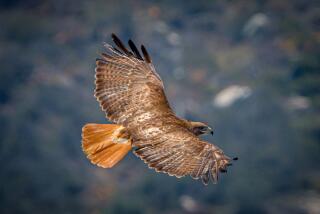Intern Program Takes Wing at Raptor Refuge
- Share via
KEMPTON, Pa. — From the jagged outcropping of rock known as Owl’s Head, the lush farmland wedged between the ridges of the Kittatinny Mountains stretches out hundreds of feet below.
Occasionally, a red-tailed hawk catches an air current and glides noiselessly past at eye level.
Jim Brett rests against a rock and scowls out at the scenery. The curator of Hawk Mountain Sanctuary in central Pennsylvania explains his weekly trips to Owl’s Head.
“Nobody’s supposed to come out here, but they do sometimes. Camp sometimes. Mess it up. . . . So I try to get out here and check it every Monday.”
Then he grins, “And it’s a good way to start a week.”
Brett, who oversees the 2,226-acre raptor sanctuary, is a character--not to mention conservationist, adventurer and mentor.
A former biology teacher in nearby York County, Brett also spent some time as a research biologist, writing impact statements for nuclear power stations. He was about to enter Cornell University to work on his Ph.D. in nature interpretation when he took the Hawk Mountain job 24 years ago.
During migration season, from August through December, Brett, 54, spends at least a few days a week perched for hours at a time on the sanctuary’s North Lookout, counting raptors, keeping records and chatting with the regulars.
Brett also does research, organizes programs and acts as teacher to the young interns he recruits from Pottstown, Pa., to Tanzania.
“We’re cutting edge,” he says proudly of his internship program. “We have two black interns from Africa, one Hispanic from Ecuador and Annette.”
Annette Edwards of Trinidad was hired by Brett recently to coordinate the sanctuary’s internship program. He had met Edwards on his travels, liked her and pursued her until she accepted the job.
She returns the admiration. “He’s such an inspiration . . . he’s wonderful,” said Edwards.
Several seasonal interns also are accepted from the United States, including three this year from New Hampshire, Massachusetts and Michigan. Brett works as hard to recruit those students as he does the foreign interns. As a result, the program has become known worldwide.
For Brett, there are no days off. His work on and off the mountain is more a lifestyle than a career.
To keep himself fresh, he leaves the mountains of Pennsylvania for up to 12 weeks a year and travels around the world.
In 1995, he has trips planned for Panama, Israel, India and Africa. He’s been invited to attend the first Jordanian Hawk Watch next fall.
Officially, Brett’s travels to Tanzania, South America, the Middle East and Asia are for finding possible interns and speakers, leading what he calls “eco-tours,” planning exhibits and raising money for Hawk Mountain.
Unofficially, he says, “If I don’t go away every once in awhile, I go whammy.”
Last March, Brett met the Dalai Lama in the Sinai Desert with a group from the Society for the Protection of Nature.
“We talked about mutual understanding of the planet,” he said with uncharacteristic reverence. “It was so provocative. . . . It was the aura. I don’t get turned on by that stuff usually, but that did something to me. Sitting high above the Red Sea, and the wind was blowing, and behind this holy man was this huge flock of black storks, and he said, ‘This is what we need to protect.’
“The whole moment transcended that particular time and place,” he said.
Brett pauses briefly, then puts his binoculars up to his eyes and scans the valley.
“I’d like to get him here. I’m working on that,” he added simply.
More to Read
Sign up for The Wild
We’ll help you find the best places to hike, bike and run, as well as the perfect silent spots for meditation and yoga.
You may occasionally receive promotional content from the Los Angeles Times.






